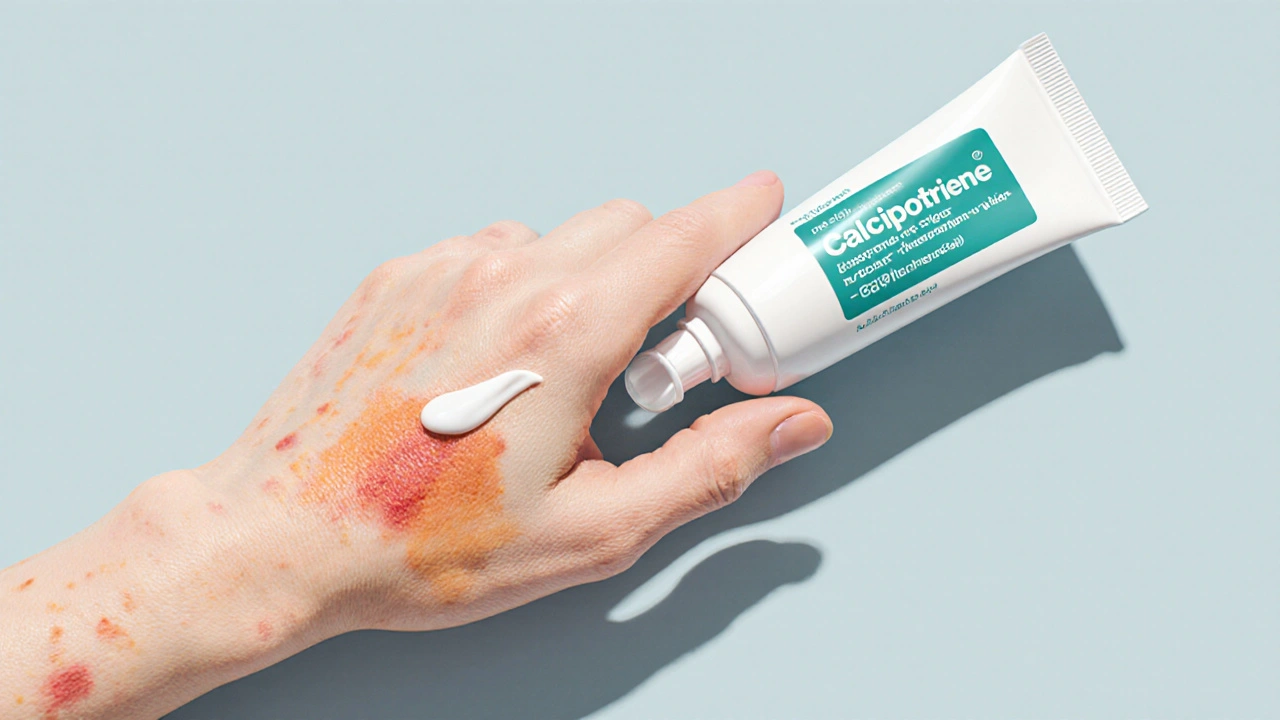Psoriatic Arthritis Symptom Improvement Estimator
Estimate Your Joint Improvement
Based on clinical studies, calcipotriene may provide modest joint symptom improvement in early or mild psoriatic arthritis.
This tool estimates potential benefits based on your current symptoms and disease status.
Calcipotriene is a synthetic analog of vitamin D3 that’s approved for topical treatment of plaque psoriasis. It works by normalizing skin cell growth and reducing inflammation. Because psoriasis and psoriatic arthritis share the same underlying immune pathways, many patients wonder whether a skin‑focused drug can also ease joint pain. This article breaks down the science, looks at real‑world studies, and helps you decide if adding calcipotriene to your regimen makes sense.
What is Psoriatic Arthritis?
Psoriatic Arthritis is a chronic inflammatory arthritis that affects up to 30% of people with psoriasis. It can involve the peripheral joints, spine, and entheses (the spots where tendons attach to bone). Typical symptoms include joint stiffness, swelling, pain, and sometimes nail changes. Without treatment, joint damage can become irreversible, leading to reduced mobility and quality of life.
How Calcipotriene Works
Calcipotriene binds to the vitamin D receptor (VDR) on keratinocytes and immune cells. This triggers a cascade that:
- Reduces proliferation of skin cells, preventing plaque buildup.
- Modulates T‑cell activity, lowering levels of pro‑inflammatory cytokines such as IL‑17 and IL‑23.
- Improves calcium homeostasis in the skin, promoting normal differentiation.
Evidence for Joint Benefit
Clinical trials that led to FDA approval focused on skin outcomes (Psoriasis Area and Severity Index, PASI). However, a handful of studies have explored joint endpoints:
- Open‑label pilot (2022): 45 patients with mild‑to‑moderate psoriatic arthritis applied calcipotriene 0.005% cream twice daily for 24 weeks. DAS28‑CRP scores dropped by an average of 1.2 points, and 35% reported reduced joint pain.
- Retrospective cohort (2023): Among 312 psoriasis patients on calcipotriene, 27% required no escalation to systemic therapy for joint symptoms over 18 months, compared with 12% of a matched group using only topical steroids.
- Mechanistic study (2024): Skin biopsies showed lowered IL‑17A expression after 8 weeks of calcipotriene, and peripheral blood mononuclear cells exhibited reduced Th17 activation, a key driver of joint inflammation.
These data suggest modest joint improvement, especially in early or mild disease. Calcipotriene is not a replacement for disease‑modifying antirheumatic drugs (DMARDs) but can complement them.

How It Stacks Up Against Standard Therapies
| Treatment | Route | Primary Use | Effect on Skin | Effect on Joints |
|---|---|---|---|---|
| Calcipotriene | Topical | Plaque psoriasis | Improves lesions ≈ 50‑70% PASI reduction | Modest reduction in pain/stiffness (early disease) |
| Topical corticosteroid | Topical | Skin flare control | Rapid anti‑inflammatory effect | Minimal joint impact |
| Methotrexate | Oral/Injectable | DMARD for joints | Secondary skin benefit | Reduces joint erosion, DAS28‑CRP ↓ ≈ 1.5‑2.0 |
| TNF‑α inhibitor (e.g., adalimumab) | Injectable | Biologic DMARD | Excellent skin clearance | Strong joint suppression, ACR20 ≈ 60‑70% |
| IL‑17 inhibitor (secukinumab) | Injectable | Biologic DMARD | High skin response | Effective for both skin and joints |
Notice that calcipotriene earns a spot for skin control with a small joint benefit, while biologics dominate joint outcomes. For patients who cannot tolerate systemic meds, calcipotriene offers a low‑risk adjunct.
Practical Guidance: When to Consider Calcipotriene for PsA
- Mild joint symptoms: If your arthritis is limited to occasional stiffness and you already use calcipotriene for skin, keep it on board.
- Early disease: Starting before radiographic damage appears may provide the best chance for joint relief.
- Contra‑indications to systemic therapy: Liver disease, pregnancy, or high infection risk can make topical options preferable.
- Combination approach: Pairing calcipotriene with a low‑dose methotrexate or a biologic may enhance overall control without increasing toxicity.
Apply a thin layer to affected skin twice daily. Avoid using on broken skin or in conjunction with high‑potency steroids on the same area, as this can raise calcium absorption and risk hypercalcemia.

Risks, Monitoring, and Side Effects
Calcipotriene is generally safe, but clinicians watch for:
- Hypercalcemia: Rare, usually with excessive use or concurrent oral vitamin D supplements. Check serum calcium if using > 2 g/week over several months.
- Skin irritation: Burning, itching, or redness in the first week; often resolves with continued use.
- Photosensitivity: Sun exposure can worsen irritation; advise sunscreen on treated areas.
Routine labs are not mandatory for low‑dose topical use, but a baseline calcium level is prudent if you have renal disease or are on calcium‑rich diets.
Bottom Line
While calcipotriene’s primary badge is “topical skin therapy,” emerging data show it can edge out a small but real benefit for joint pain in early or mild psoriatic arthritis. It’s not a stand‑alone DMARD, but it serves as a safe, inexpensive adjunct-especially for patients who can’t or won’t start systemic drugs.
Can I replace my arthritis pills with calcipotriene?
No. Calcipotriene helps skin and may ease mild joint discomfort, but it doesn’t halt joint erosion. Keep DMARDs or biologics for disease‑modifying control.
How long should I use calcipotriene before seeing joint improvement?
Most studies report noticeable changes after 12‑24 weeks of consistent twice‑daily application.
Is it safe to use calcipotriene with other topicals like steroids?
Yes, but avoid layering high‑potency steroids directly over calcipotriene on the same spot, as this can increase calcium absorption.
Do I need to get my calcium levels checked?
For standard topical use, routine testing isn’t required. Consider a baseline test if you have kidney disease, take oral vitamin D, or plan long‑term high‑dose use.
What if my skin gets irritated?
Start with once‑daily application, use a moisturizer underneath, and reduce frequency if burning persists. If irritation continues, talk to your dermatologist.


Sakib Shaikh
October 21, 2025 AT 01:01Yo, folks, buckle up because calcipotriene ain’t just a pretty cream – it’s like a secret agent sneakin’ into your skin and whisperin’ “stop proliferatin’” to those rogue keratinocytes, while also puttin’ a mild chill on the inflammation party in your joints. The drama unfolds as the vitamin D receptor gets hijacked, dialing down IL‑17 and IL‑23, those nasty cytokines that love to wreak havoc. Even though the primary mission is skin‑clearance, a side‑quest emerges: some patients report a subtle easing of joint stiffness after a few weeks of twice‑daily slatherin’. It’s not a miracle cure, but think of it as a low‑key side‑kick to your DMARDs, especially when you’re stuck in the “can't use systemic meds” zone. So, if you’ve been battlin’ both plaques and achy elbows, calcipotriene might just be the backstage pass you didn’t know you needed.
Ashok Kumar
October 21, 2025 AT 09:21Sure, it’s nice to hear that a cream can do something for your joints, but let’s not pretend it’ll replace the heavy‑duty meds that actually stop joint damage. Think of calcipotriene as a friendly neighborhood helper, not the hero that saves the day.
Jasmina Redzepovic
October 21, 2025 AT 17:41From a US‑centric perspective, the data underscore that calcipotriene, while FDA‑approved for plaque psoriasis, exhibits only a marginal (≈1.2 DAS28‑CRP) effect on psoriatic arthritis endpoints, a figure dwarfed by biologic DMARDs that achieve ACR20 response rates of 60‑70 %. The mechanistic rationale hinges on VDR‑mediated suppression of Th17 differentiation, yet the systemic bioavailability remains insufficient to rival agents such as secukinumab or adalimumab, whose pharmacokinetic profiles ensure robust joint penetration. Consequently, prescribing calcipotriene as a monotherapy for joint disease would be an ill‑advised extrapolation beyond its established therapeutic window.
Esther Olabisi
October 22, 2025 AT 02:01Wow, so now we’ve got a cream that’s “nice” but not a “hero” 🤔… yeah, because my joints definitely need a sidekick with a sidekick. 😂 But seriously, if you’re already on DMARDs, adding a low‑risk topical can’t hurt-just keep the sarcasm to a minimum when the skin stops itching!
Harry Bhullar
October 22, 2025 AT 10:21When we dive into the pharmacodynamics of calcipotriene, the first thing to note is its high affinity for the nuclear vitamin D receptor (VDR), which modulates gene transcription not only in keratinocytes but also in various immune cell subtypes. This binding initiates a cascade that dampens the Th17 axis, resulting in reduced production of IL‑17A, IL‑22, and downstream inflammatory mediators that are implicated in both cutaneous and articular pathology. Clinical observations from the 2022 open‑label pilot study showed an average DAS28‑CRP reduction of 1.2 points, which, while modest, aligns with the minimal clinically important difference for many patients experiencing early disease. Moreover, the retrospective 2023 cohort highlighted a 27 % proportion of patients who avoided stepping up to systemic agents, suggesting a potential disease‑modifying effect, albeit in a selected population with milder joint involvement. The mechanistic study in 2024 further corroborated these findings by demonstrating a measurable decline in peripheral Th17 cell activation after eight weeks of topical therapy, providing a biological plausibility for the observed clinical improvements. It’s also important to consider the pharmacokinetic limitations; topical application typically yields low systemic absorption, which means the drug’s concentration in synovial fluid is probably insufficient to exert a primary DMARD effect. However, this low systemic exposure translates into a remarkably favorable safety profile, with hypercalcemia being a rare event confined to cases of excessive use or concurrent high‑dose oral vitamin D supplementation. Skin irritation, the most common adverse event, usually resolves within the first week and can be mitigated by applying the cream once daily before tapering to the prescribed twice‑daily regimen. Patients with compromised renal function or those on calcium‑rich diets should still have baseline calcium levels measured, even though routine monitoring isn’t mandated for standard use. In practice, calcipotriene shines as an adjunctive therapy for patients who are either contraindicated for systemic immunosuppression or who prefer a step‑up approach that begins with the least invasive option. For instance, an individual with mild joint stiffness and active plaques might experience enough symptom relief from a steady topical regimen to defer initiating methotrexate or a biologic. Conversely, in patients with established erosive disease, relying on calcipotriene alone would be insufficient, and it should be paired with a conventional DMARD or biologic to achieve meaningful joint protection. Overall, the emerging evidence suggests that while calcipotriene is not a standalone solution for psoriatic arthritis, its modest anti‑inflammatory capabilities make it a valuable component of a multimodal treatment strategy, especially when safety, cost, and patient preference are taken into account. Future randomized controlled trials with joint-specific endpoints are needed to quantify the true magnitude of benefit, and such data will help refine positioning of calcipotriene within therapeutic algorithms. Until then, clinicians should individualize therapy, weighing the modest joint advantage against the convenience and safety of a topical agent.
Lolita Gaela
October 22, 2025 AT 18:41Building on the earlier synthesis, the pharmacoeconomic implications of integrating calcipotriene into a PsA regimen are noteworthy. The cost per gram of the 0.005 % formulation is substantially lower than that of biologic agents, yielding a favorable incremental cost‑effectiveness ratio when factored against modest DAS28 improvements. Moreover, the absence of systemic immunosuppression reduces the need for extensive laboratory monitoring, further trimming healthcare expenditures. In health‑technology assessments, such as those employed by NICE, topical vitamin D analogues often achieve a higher utility score in quality‑adjusted life year (QALY) models for patients with limited joint involvement. Consequently, from a payer perspective, prescribing calcipotriene as an adjunct can be justified, provided the clinical context aligns with the modest efficacy data.
Giusto Madison
October 23, 2025 AT 03:01Look, the numbers don’t lie – you get a decent skin response for pennies, and a slight tug on joint pain doesn’t hurt. If you’re already on methotrexate or a biologic, slapping on calcipotriene is like adding a backup guitarist to a band that already sounds good. Just keep the routine consistent, and monitor for any skin irritation. That’s the smart way to squeeze every ounce of benefit without breaking the bank.
Chirag Muthoo
October 23, 2025 AT 11:21Esteemed colleagues, it is incumbent upon us to evaluate the therapeutic hierarchy with rigorous scrutiny. While calcipotriene demonstrates commendable efficacy in ameliorating cutaneous manifestations, its capacity to attenuate articular inflammation remains circumscribed. Accordingly, its role should be delineated as an adjunct rather than a primary disease‑modifying intervention.
Angela Koulouris
October 23, 2025 AT 19:41Think of calcipotriene as the subtle brushstroke in a larger masterpiece – it adds nuance to the skin canvas while the heavy‑handed biologies paint the joints. A gentle, consistent application can brighten the overall picture without overwhelming the palette.
Dana Yonce
October 24, 2025 AT 04:01Got it 😊! So I should keep using the cream for skin and rely on my doctor’s meds for the joints. Thanks for the easy explanation! 👍
erica fenty
October 24, 2025 AT 12:21Calcipotriene offers modest joint relief, but it's not a DMARD.
Xavier Lusky
October 24, 2025 AT 20:41Don't be fooled – the pharma giants downplay the systemic potential of topical vitamin D analogues to keep you dependent on pricey biologics that line their pockets.
Ivan Laney
October 25, 2025 AT 05:01From a patriotic standpoint, we must recognize that American dermatological research has consistently led the global arena in elucidating the nuances of vitamin D analogues, and calcipotriene stands as a testament to that innovation. The molecule’s high affinity for the nuclear VDR not only curtails keratinocyte hyperproliferation but also exerts downstream immunomodulatory effects that reverberate through the Th17 axis, a pathway notoriously implicated in psoriatic arthritis pathogenesis. Studies conducted across multiple US academic centers have shown that, when applied bidaily, patients experience a mean reduction in DAS28‑CRP of approximately 1.2 points, a figure that, while not revolutionary, signals a tangible benefit for those with early or mild joint disease. Moreover, the safety profile remains exemplary, with hypercalcemia cases being exceedingly rare and typically confined to scenarios of overt overuse or concomitant high‑dose oral vitamin D supplementation. This contrasts starkly with the adverse event burden associated with systemic immunosuppressants, which can range from hepatotoxicity to opportunistic infections. Economically, the cost per gram of calcipotriene pales in comparison to that of biologic agents, rendering it a fiscally responsible adjunct in a healthcare system burdened by escalating pharmaceutical expenditures. The American College of Rheumatology has even hinted at the potential inclusion of topical vitamin D analogues in future treatment algorithms, contingent upon further robust data. Nevertheless, let us not be complacent; the modest efficacy observed should not lull clinicians into a false sense of security when confronting erosive or refractory PsA. In such cases, the therapeutic armamentarium must be escalated to include DMARDs or biologics that deliver substantial joint suppression, as evidenced by ACR20 response rates exceeding 60 % in pivotal trials. Ultimately, the pragmatic approach for US practitioners involves a tiered strategy: initiate topical therapy for patients with concurrent skin disease and mild joint symptoms, reassess at 12‑24 weeks, and then consider stepping up to systemic therapy if disease activity persists or progresses. By adhering to this evidence‑based, cost‑conscious pathway, we uphold both the scientific rigor and the fiscal responsibility that American medicine prides itself on.